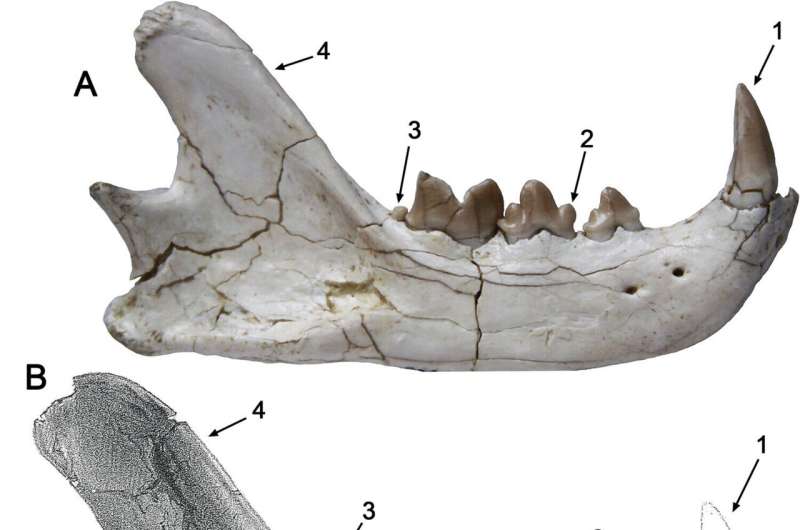New species of ancient feline discovered in Spain

A small team of paleontologists at Museo Nacional de Ciencias Naturales-CSIC has discovered a new species of ancient feline based on study of a jawbone fossil. In their paper published in Journal of Vertebrate Paleontology, the group describes a jawbone fossil uncovered near what is now Madrid, some of its features and where it fits in on the family tree of felines.
Prior research has suggested that felines first evolved approximately 25 million years ago. In this new effort, the research team has found evidence of a feline that lived approximately 15.5 million years ago, near what is now Madrid, Spain.
The evidence came in the form of a nearly complete hemimandible (half of a lower jawbone), including all its teeth except the incisors. It was discovered at a dig site called Príncipe Pío-2 in 2007, where construction had been underway to extend a metro stop to a shopping center. It was taken to the National Museum of Natural Sciences where it was archived. The research team describes the fossil as well preserved.
Study of the fossil found that its owner belonged to a new feline species, one they named Magerifelis peignei. The researchers found that the ancient cat belonged to a sister clade that now includes modern species such as Lynx pardinus. The team also noted that the cat had a unique feature: a lower second molar, which is present in just one modern cat.
They estimated that the feline weighed approximately 7.61kg, making it nearly twice as heavy as a modern house cat—on par with the modern lynx or bobcat. They also noted its hemimandible was large in proportion to the rest of its body, which would have given the cat a robust appearance.
Thus, the cat had a strong bite, allowing it to take down relatively large prey—likely by tearing at the throat. It also meant that the cat would have been able to purr, but not roar.
The researchers note that the fossil, because of its second molar, also helps to fill in some gaps in feline evolutionary history.
More information: Manuel J. Salesa et al, Unraveling the diversity of early felines: a new genus of Felinae (Carnivora, Felidae) from the Middle Miocene of Madrid (Spain). Journal of Vertebrate Paleontology (2024). DOI: 10.1080/02724634.2023.2288924
Journal information: Journal of Vertebrate Paleontology
© 2024 Science X Network
New look at a Lorrainosaurus in a museum finds plesiosaurs evolved earlier than thought
No comments:
Post a Comment